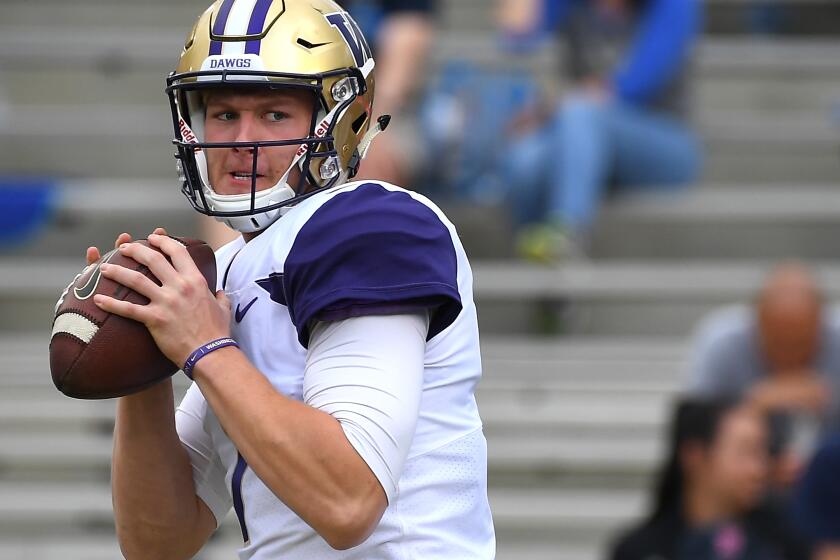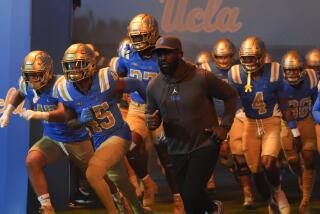Matt Lynch finds new possibilities with new position at UCLA

- Share via
Matt Lynch is wearing a new number, one that seems to come with certain conditions in recent years at UCLA.
Must have converted from quarterback to tight end. Must be overlooked. Must wildly exceed expectations.
“Got some shoes to fill wearing 81,” Lynch said.
Caleb Wilson, the last Bruin to wear the number, went from walk-on to wonder. As a senior last season, Wilson led all college tight ends with 965 receiving yards and was selected by the Arizona Cardinals with the final pick of the NFL draft, earning the designation of “Mr. Irrelevant.”
Lynch knows what it’s like to be discounted. A three-star prospect out of Broomfield, Colo., he did not play in 2016, his first college season. He was third on the depth chart in his second season. He slipped to the team’s fourth option at quarterback last season.
It was time for a new position and new possibilities.
“I just wanted that chance to get on the field and do something,” Lynch said.
The redshirt junior always had the build to play tight end, with a body that stood 6 feet 4 and could carry well more than the 207 pounds that he stocked at quarterback. He also possessed the durability to block bigger counterparts and the speed to run with faster defensive backs.
UCLA coach Chip Kelly says Washington blocked transfer Colson Yankoff’s bid to gain immediate eligibility, forcing the quarterback to sit out again.
It’s all come together during the first 10 days of the Bruins’ training camp.
“The ultimate compliment you would probably [give] is he really looks like a tight end right now,” UCLA coach Chip Kelly said earlier this week. “He doesn’t look like a quarterback playing another position, he looks like a tight end and he fits in really well with that group.”
Quarterback Josh Rosen saw the potential genius of the position switch for his understudy during Rosen’s final season at UCLA in 2017 and suggested the move to Jedd Fisch, who was then the Bruins’ offensive coordinator. Fisch liked the idea, but Lynch remained at quarterback.
He was needed late in the season after Rosen sustained a concussion and backup Devon Modster injured his thumb. Entering early in the fourth quarter of a blowout loss to Utah, Lynch did not appear overmatched, running twice for 15 yards and completing two of three passes, including a five-yard touchdown to Eldridge Massington.
But the cameo did not trigger a move up the depth chart. Lynch opened the 2018 season stuck behind Wilton Speight, Dorian Thompson-Robinson and Austin Burton in the quarterback pecking order. His only game action came as the holder on placekicks.
Before spring practice, Kelly asked Lynch whether he wanted to make the move to tight end. It would involve Lynch packing on pounds and developing a more physical mind-set in addition to learning the nuances of a new position.
There would be no more wearing a red jersey in practices to signal he’s off limits from contact. He was going to get hit.
“Quarterbacks are all like, ‘Oh, they’re soft,’ and all that,” Lynch said of the perception of the position, “so putting your facemask into somebody and having to drive [them] and give it your all every play, that was probably the hardest thing.”
It’s helped that Lynch has bulked up to 234 pounds and drastically enhanced his strength. He’s also added a unique perspective to the tight ends group as someone who knows where the quarterbacks want them to be when they’re running routes, particularly when the plays break down.
“He has a lot of knowledge when it comes to schemes and coverages,” tight end Devin Asiasi said of his teammate, “and knowing where everybody’s supposed to be.”
Boss Tagaloa’s move to center last season from defensive end changed the trajectory of UCLA’s offense. Now the line is the Bruins’ strength.
Tight ends do not lack for opportunity in a Kelly offense. The coach favors formations with two and even three tight ends and likes to spread the ball around the field. It could herald big things for a diverse group.
Asiasi, a transfer from Michigan who has been placed on the watch list for the Mackey Award that goes to the nation’s top tight end, is widely expected to have a breakout season. Jordan Wilson, at 6-4 and a chiseled 234 pounds, might be the best blocker of UCLA’s tight ends. Greg Dulcich, a walk-on who caught his first pass in the 2018 season finale against Stanford, is a candidate to receive a scholarship.
None of them will have had as unlikely a journey as the new No. 81. Just this week, Lynch was forced to give up the No. 15 that was practically a family heirloom, having worn it all through childhood as a tribute to the father and little brothers who either wore Nos. 15 or 51. It was no longer an option after Kelly told Lynch that he wanted all his tight ends to wear a number in the 80s.
The jersey switch also sparked a conversation between Lynch and the last Bruin to make his new number special.
“He said I’m the one he wants to have it,” Lynch said of Caleb Wilson, “so I’ve got to step up and make him proud.”
More to Read
Go beyond the scoreboard
Get the latest on L.A.'s teams in the daily Sports Report newsletter.
You may occasionally receive promotional content from the Los Angeles Times.








